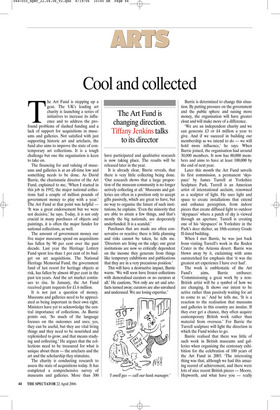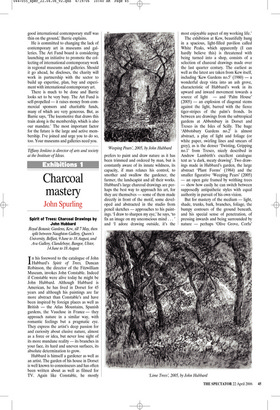Cool and collected
The Art Fund is changing direction. Tiffany Jenkins talks to its director
The Art Fund is stepping up a gear. The UK’s leading art charity is launching a series of initiatives to increase its influence and to address the profound problems of slashed funding and a lack of support for acquisitions in museums and galleries. Not satisfied with just supporting historic art and artefacts, the fund also aims to improve the state of contemporary art collections. It is a tough challenge but one the organisation is keen to take on.
The financing for and valuing of museums and galleries is at an all-time low and something needs to be done. As David Barrie, the charismatic director of the Art Fund, explained to me, ‘When I started in this job in 1992, the major national collections had a couple of million pounds of government money to play with a year.’ The Art Fund at that point was helpful — ‘It was a great endorsement but we were not decisive,’ he says. Today, it is not only crucial in many purchases of objects and paintings, it is often the major funder for national collections, as well.
The amount of government money our five major museums spend on acquisitions has fallen by 90 per cent over the past decade. Last year the Heritage Lottery Fund spent less than 1 per cent of its budget on art acquisitions. The National Heritage Memorial Fund, the government fund of last resort for heritage objects at risk, has fallen by almost 40 per cent in the past ten years. And the art market continues to rise. In January, the Art Fund received grant requests for £1.6 million.
It is not just a question of money. Museums and galleries need to be appreciated as being important in their own right. Ministers have yet to acknowledge the central importance of collections. As Barrie points out, ‘So much of the language focuses on the outcomes and uses; yes, they can be useful, but they are vital living things and they need to be nourished and replenished to grow, and that means studying and collecting.’ He argues that the collections need to be treasured for what is unique about them — the artefacts and the art and the scholarship they stimulate.
The charity is conducting research to assess the state of acquisitions today. It has completed a comprehensive survey of museums and galleries. More than 300 have participated and qualitative research is now taking place. The results will be released later in the year.
It is already clear, Barrie reveals, that there is very little collecting being done. ‘Our research shows that a large proportion of the museum community is no longer actively collecting at all.’ Museums and galleries are often in a position only to accept gifts passively, which are great to have, but no way to organise the future of such institutions, he explains. ‘Even the minority that are able to attain a few things, and that’s mostly the big nationals, are desperately underfunded. It is a scandal.’ Purchases that are made are often conservative or reactive; there is little planning and risks cannot be taken, he tells me. ‘Directors are living on the edge; our great institutions are now so critically dependent on the income they generate from things like temporary exhibitions and publications that they are in a very precarious position.’ This will have a destructive impact, Barrie warns. ‘We will soon have frozen collections with demoralised curators or no curators at all.’ He cautions, ‘Not only are art and artefacts turned away; curators are also unvalued and underused. We are losing expertise.’ Barrie is determined to change this situation. By putting pressure on the government and the public sphere and raising more money, the organisation will have greater clout and will make more of a difference.
‘We are an independent charity and we can generate £3 or £4 million a year to give. And if we succeed in building our membership as we intend to do — we will hold more influence,’ he says. When Barrie joined, the organisation had around 30,000 members. It now has 80,000 members and aims to have at least 100,000 by the end of next year.
Later this month the Art Fund unveils its first commission, a permanent ‘skyspace’ by James Turrell at Yorkshire Sculpture Park. Turrell is an American artist of international acclaim, renowned as a sculptor of light. He uses light and space to create installations that extend and enhance perception, from indoor pieces that create diffused light to outdoor ‘skyspaces’ where a patch of sky is viewed through an aperture. Turrell is creating one of his ‘skyspaces’ in Yorkshire in the Park’s deer shelter, an 18th-century Grade II-listed building.
When I met Barrie, he was just back from visiting Turrell’s work in the Roden Crater in the Arizona desert. Barrie was blown away by it, exclaiming with arms outstretched for emphasis that ‘it was the greatest art experience I have ever had’.
The work is emblematic of the Art Fund’s aims, Barrie enthuses: ‘Commissioning a great work by a nonBritish artist will be a symbol of how we are changing. It shows our intent to be active rather than passively waiting for art to come to us.’ And he tells me, ‘It is a reaction to the realisation that museums and galleries in this country are insular. If they ever get a chance, they often acquire contemporary British work rather than material from overseas.’ For Barrie the Turrell sculpture will light the direction in which the Fund wishes to go.
Barrie realised that there was little of such work in British museums and galleries when organising the centenary exhibition for the celebration of 100 years of the Art Fund in 2003. ‘The interesting thing was that, although we had this amazing record of achievement, and there were lots of nice recent British pieces — Moore, Hepworth, and what have you — really good international contemporary stuff was thin on the ground,’ Barrie explains.
He is committed to changing the lack of contemporary art in museums and galleries. The Art Fund board is considering launching an initiative to promote the collecting of international contemporary work in regional museums and galleries. Should it go ahead, he discloses, the charity will work in partnership with the sector to build up expertise, plan, buy and experiment with international contemporary art.
There is much to be done and Barrie looks set to be very busy. The Art Fund is self-propelled — it raises money from commercial sponsors and charitable funds, many of which are very generous. But, as Barrie says, ‘The locomotive that draws this train along is the membership, which is also our mandate.’ The most important factor for the future is the large and active membership. I’ve joined and urge you to do so, too. Your museums and galleries need you.



































































 Previous page
Previous page